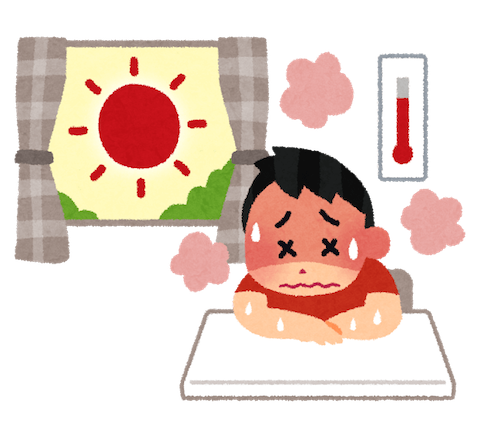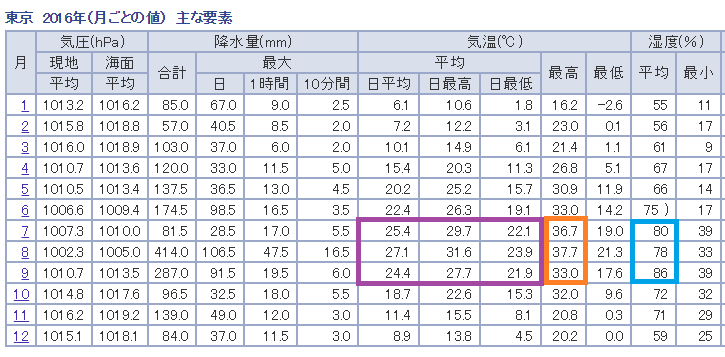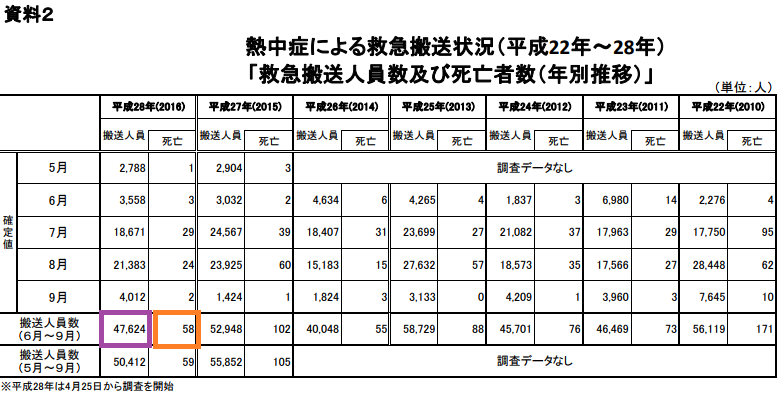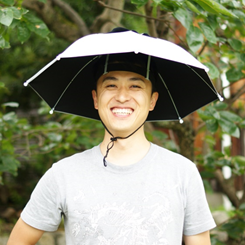2017
Beat the Beastly Japanese Summer Heat: A guide to weather, parasols, and skin cooling

Summer has begun. It’s hot, humid, and borderline miserable already. Nighttime is still bearable, but soon, that reprieve of cool darkness will be torn away from us, and in its place will be nothing but muggy, stagnant hellscape. Air conditioners are a godsend, but there’s always that dreaded moment we have to go back outside and get soaked with sweat all over again just by existing.
- Come on, it can’t be that bad
- Heat Exhaustion and Heat Stroke
- Heat exhaustion
- Dealing with the heat
Come on, it can’t be that bad
Look. It’s no India, where thousands of people die from extreme temperatures. But it is still bad and people do die. People have already died of heat stroke in Japan, and summer isn’t even in full swing. And thanks to global warming, it’s only getting worse, year by year. Let’s take a look at the average summer temperatures last year. To see the entire chart, click the link below to be redirected to the Japan Meteorological Agency.
http://www.data.jma.go.jp/obd/stats/etrn/view/monthly_s1.php

The numbers selected above are as follows:
Purple: Average temperature, average high, and average low (left to right, respectively) for July, August, and September (up to down) of 2016.
Orange: Hottest recorded temperature for July, August, and September (up to down).
Blue: Average humidity for July, August, and September (up to down).
Last July, the average high was 29.7 degrees Celsius (85.5F), with the highest recorded temperature that month being 36.7C (98F). That alone is pretty hot, but the 80% average humidity that goes with it is oppressive. Then, looking at August things get worse.
The average temperature last August was 27.1C (89F), with the highest recorded temperature that month being 37.7C (100F). The humidity got a little better at 78% but with the temperature increase, it actually feels worse. Things appear to get cooler in September, but the humidity spiked up to 86%. Going outside in August and September feels like stepping into hot soup.
This is not only horrendously uncomfortable, particularly if you have to wear a suit or a bra, (that bra goes from being a minor annoyance to a tight, wet, vice grip around your rib cage), or both, it can also be very dangerous.
Heat Exhaustion and Heat Stroke
Heat exhaustion and heat stroke are two very real dangers when you live in Japan. According to the Fire and Disaster Prevention Agency, last year (2016) from June thru September, 47,624 people were taken to the hospital by ambulance for symptoms of heat stroke. Of those, 58 died.

Of the 7 years described in the chart, last year was on the low end with deaths, but 58 people either didn’t get to the hospital in time or their symptoms were too severe when an ambulance was finally called.
It’s important to recognize the symptoms of heat exhaustion and heat stroke, and to take the appropriate measures so that you don’t become a statistic.
Heat exhaustion
- heavy sweating
- rapid pulse
- dizziness
- fatigue
- cool, moist skin with goose bumps when in the heat
- muscle cramps
- nausea
- headache
If you or someone you know is experiencing or appears to be experiencing these symptoms, help the person get into a cool area and hydrate. It is important to remember to hydrate with not only water, but sports drinks that contain electrolytes, like Pocari Sweat or Aquarius.
Do NOT consume sugary drinks, juices, or alcohol. Misting the body with cool water may help, or removing unnecessary clothing.
Heat stroke
- altered mental state or behavior
- nausea and vomiting
- flushed skin
- rapid breathing
- racing heart rate
- dry skin, no longer sweating
If you or someone you know is experiencing or appears to be experiencing these symptoms, seek immediate medical attention. There is no shame in calling an ambulance (dial 119 in Japan!), and it is better to be safe than sorry. Heat stroke is nothing to smirk at, and can be deadly as it can cause organ failure.
Here is a helpful PDF that you can easily print or download from the Fire and Disaster Prevention Agency about heat emergencies and emergencies in general.
http://www.fdma.go.jp/neuter/topics/pdf/kyuukyuusya_riyou_guide.pdf
Dealing with the heat
There are a number of ways that you can avoid getting too hot.
1. Hydrate, hydrate, hydrate!
Make sure you have at least a bottle of water (disposable, reusable, whatever, just have water). When you start to feel tired or dizzy, make sure you also drink a sports drink to replenish your salt levels so your body can regulate its temperature. Sweating causes you to lose salt over time, and the more depleted it gets, the harder it is for your body to keep from overheating. Grab a Pocari Sweat, Aquarius, Green Dakara, or other sports drink.
If you don’t want to get another plastic bottle, you can make your own at home to pour into your reusable bottle. You can buy a powdered version of Aquarius to put into plain water, or you can make an electrolyte drink from scratch.
Electrolyte drink recipe:
500ml water
2 tsp ~ 2 tbsp granulated sugar
(you can add any amount between the two, but should generally not exceed 2 tbsp as sugary drinks can make an overheating situation worse)
¼ tsp salt
juice of ½ lemon (or 1.5 tsp of bottled lemon juice)
Mix well. Give it a good shake now and again until the sugar and salt have dissolved. Drink whenever you need it. (you can add any amount of sugar between 2 tsp and 2 tbsp, but should generally not exceed 2 tbsp as sugary drinks can make an overheating situation worse)
2. Keep body cooling wet sheets with you
Gatsby and Bioré make a line of mentholated body wipes that moisten your skin and leave a cool feeling behind. The removal of sweat, evaporation of the cloth liquid, and lingering minty feel can help you cool down. Few, if any brands marketed for women offer these kinds of mentholated body sheets, so ladies, feel free to grab some of the men’s ones.
If it comes down to smelling like a dude or being so hot I potentially overheat, I’ll take the dude smell any day. We’ve got a list of the most popular cooling products on our site. You can check it out here (scroll to section 3):
https://www.lifeabroad.jp/html/daily_life/heating_ac.html#cooling
3. Use a parasol
Parasols are a popular way to keep the sun off you and have portable shade everywhere you go. This can help keep you from overheating. Some parasols can be used in rain or shine, but make sure you check the label before you pop it open in a downpour. Parasols with a darker interior fabric will also keep UV rays that bounce up off the ground from bouncing back of a light fabric and onto you, so check the colour of the interior fabric as well.
A note from Ken:
Generally Japanese men don’t use parasols. It is very hot so I think Japanese men should use parasols too, because it is not only for staying cool but preventing men from having skin cancer. We need to break the stereotype that only women can use parasols so we can be comfortable, too!
Also, this is a hat I found online but I have never seen. If you see someone wearing this hat in the street , you have had a special experience.

4. Give yourself a break
With summer comes lots of outdoor activities, many of which can last all day long. In these situations, it’s important to give your body a break from constantly trying to regulate its temperature. Find a shaded area and sit down or pop into a convenience store for a bit. Your body will thank you.
For information on popular sunscreens in Japan, check out our site at:
https://www.lifeabroad.jp/html/personal_care/sunscreen.html
Some of the sunscreens are also mentholated, which can help you feel cool, as well.
Stay safe and have fun, everyone!